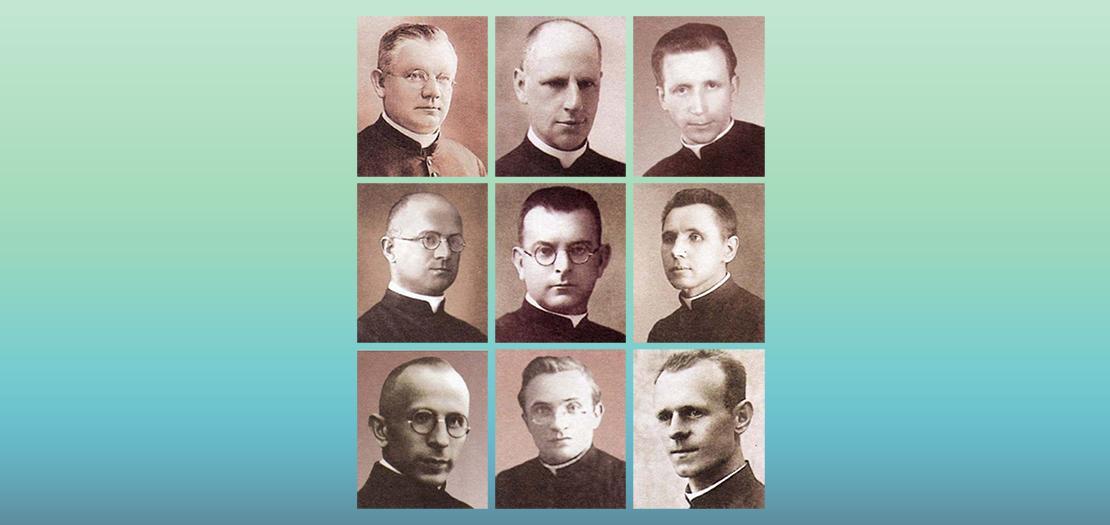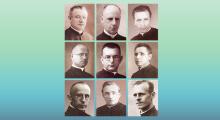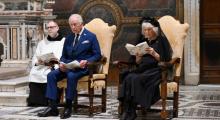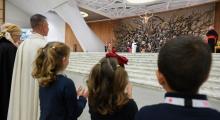Issued by the Catholic Center for Studies and Media - Jordan. Editor-in-chief Fr. Rif'at Bader - موقع أبونا abouna.org

Eleven new Blesseds will soon be venerated in the Church. During an audience granted to Cardinal Marcello Semeraro, Prefect of the Dicastery for the Causes of Saints, on Friday, Pope Leo XIV authorized the promulgation of decrees concerning the martyrdom, out of “hatred of the faith,” of nine Polish Salesians, killed between 1941 and 1942, in the concentration camps of Auschwitz and Dachau; and of two diocesan priests from the former Czechoslovakia, murdered between 1951 and 1952 during the persecution carried out against the Catholic Church by the communist regime established in the country after the Second World War.
With the Pope’s approval, the Dicastery also promulgated decrees recognizing the heroic virtues of four Servants of God, who thus become Venerable: María Evangelista Quintero Malfaz, Cistercian nun; Angelo Angioni, diocesan priest, founder of the Missionary Institute of the Immaculate Heart of Mary; José Merino Andrés, Dominican priest; and Gioacchino of the Queen of Peace, friar of the Order of Discalced Carmelites.
Martyred by the Nazis
Salesians Jan Świerc, Ignacy Antonowicz, Ignacy Dobiasz, Karol Golda, Franciszek Harazim, Ludwik Mroczek, Włodzimierz Szembek, Kazimierz Wojciechowski, and Franciszek Miśka – all religious men engaged in pastoral and educational work – were victims of Nazi persecution following the German occupation of Poland on 1 September 1939, which was unleashed with particular ferocity also against the Catholic Church.
Uninvolved in the political tensions of the time, they were arrested simply because they were Catholic priests. The special fury reserved for the Polish clergy, who were insulted and persecuted, can be seen in the actions taken against them. In the concentration camps, the religious offered spiritual comfort to their fellow prisoners and, despite the humiliations and tortures endured, continued to manifest their faith. Mocked with insults to their ministry, they were tortured and killed outright, or lost their lives on account of the inhuman conditions of their imprisonment.
Aware that their pastoral ministry was considered by the Nazis as opposition to the regime, they nonetheless continued their apostolic work, remaining faithful to their vocation and serenely accepting the risk of being arrested, deported, or killed.
Martyrs under the Communist regime in Czechoslovakia
Fathers Jan Bula and Václav Drbola, of the Diocese of Brno were killed in Jihlava, out of hatred for the faith. Because of their pastoral zeal, both were considered dangerous by the communist regime that had been established in Czechoslovakia in 1948 and had begun open persecution against the Church.
Even though he had been arrested on 30 April 1951 and remained in prison, Father Bula, the victim of a conspiracy by the state secret police, was accused of inspiring an attack on 2 July 1951 in Babice in which several communist officials were killed. He was tried and sentenced to death, and on 20 May 1952, was hanged at the prison in Jihlava.
Father Drbola, arrested by deceit on 17 June 1951 also accused of involvement in the Babice attack while imprisoned in the same jail, and was condemned to death and executed on August 3, 1951.
Deceived and imprisoned through a plot devised by false witnesses, the two priests endured violence and torture that led to the distortion of events, and were eventually forced to sign false confessions of guilt. They were convicted and sentenced to death in show trials managed by the regime.
Aware of the dangers they faced in that context of intense hostility toward the Church, and despite the harshness of imprisonment and the tortures endured, they accepted their fate with faith and trusting abandonment to the will of God, as attested by the letters they wrote before execution and by the testimony of the priest who heard Jan Bula’s confession.
The four new venerables:
With the decrees promulgated today, four new Venerables are now also recognized by the Church:
María Evangelista Quintero Malfaz, who lived between the 16th and 17th centuries, was born in Cigales, Spain, on 6 January 1591, into a family of deep Christian faith. Orphaned at a young age, she followed her religious vocation and entered the Cistercian monastery of Saint Anne in Valladolid. Exemplary in carrying out the tasks entrusted to her, she experienced mystical graces which she recounted in writing, guided by her confessors, Gaspar de la Figuera and Francisco de Vivar.
In 1632, with the founding of a Cistercian monastery at Casarrubios del Monte, in the province of Toledo, she was sent to the new community and became abbess on 27 November 1634, fostering a life of prayer and contemplation. She continued to have mystical experiences that left visible outward signs.
In 1648 her health became frail, and struck by serious illness, she died on November 27 of that same year. She was buried in the Chapter Hall of the Monastery, and five years later, upon examination, her body was found incorrupt, while her fame for holiness grew.
Her constant dialogue with God was the dominant element of her spiritual journey, leading her to perceive and offer herself as a victim with Christ for the conversion of sinners. She ardently practiced the theological virtues, trusting in the Lord to face life’s difficulties, and bore adversity and physical frailty with patience. She also lived charity toward God by striving to fulfill His will in every circumstance with great humility.
Angelo Angioni, a diocesan priest, was born on 14 January 1915, in Bortigali, Sardinia, into a large family. Raised in an environment of lively religious faith, after seminary studies he was ordained priest on 31 July 1938. After ten years of ministry as assistant pastor and then pastor, in 1948 he was appointed rector of the diocesan seminary of Ozieri and worked to establish a diocesan community of missionary priests consecrated to popular and foreign missions, following the example of Blessed Paolo Manna.
As a fidei donum priest, he went to Rio Preto, where he fulfilled his missionary ideal, dedicating himself not only to pastoral work but also to social and educational activity, promoting the creation of a parish school and founding the Missionary Institute of the Immaculate Heart of Mary, composed of priests, deacons, contemplative nuns, and laypeople. Thanks to his initiative, churches, chapels, retreat houses, religious residences, and spaces for the elderly and parish activities were built. He also produced numerous informational booklets printed with the press he had equipped his Missionary Institute with. Among his final apostolic and missionary works was the creation of an Institute of Religious Sciences.
His intense pastoral activity was slowed by two strokes, in 2000 and 2004, which left him greatly weakened. His earthly life ended on 15 September 2008. In his apostolate his love for the Lord and his zeal to transmit it to those entrusted to his pastoral care shone forth. Throughout his life he lived evangelical poverty, possessing only what was essential.
José Merino Andrés discovered his vocation through participation in his parish and in Catholic Action. Born in Madrid, Spain, on 23 April 1905, he entered the Dominican convent of San Esteban in Salamanca on July 22, 1933. Six years later, he was ordained priest, then sent to the convent of La Felguera in Asturias and later to the convent of Our Lady of Atocha in Madrid. He devoted himself intensely to preaching the Word of God and celebrating the sacraments, and in 1949 was sent to Mexico, where he dedicated himself to popular missions.
Recalled to Spain to serve as master of novices, he settled in Palencia, where he began the longest and most fruitful period of his priestly ministry, forming, between 1950 and 1966, more than 700 young men. Despite increasingly fragile health, he devoted his final energies to popular preaching. He died on December 6, 1968.
An exemplary religious, he distinguished himself in his missions by his fervent and spiritually powerful preaching and by the time he dedicated to prayer. In his apostolate, he always bore witness to firm hope and constant trust in divine mercy, manifesting his fervent devotion to the Virgin Mary, practicing charity toward others, and living always with humility, poverty of spirit, and obedience to his superiors.
Born Leone Ramognino, Gioacchino of the Queen of Peace, came from Sassello, in the province of Savona, Italy, where he was born on 12 February 1890. His baptismal name was given in honour of Pope Leo XIII. He grew up in a deeply religious family environment and was active in parish life. A carpenter by trade, he later served as a corporal major in the First World War, distinguishing himself in the construction of bridges and canals on the Isonzo and the Piave, earning the honour of Cavaliere di Vittorio Veneto.
After returning to Sassello, he collaborated with the parish priest in founding the Saint Louis Club for youth education, became an active member of the Mutual Aid Society of Saint Alphonsus Maria de’ Liguori, and helped found a Catholic scout group in his town.
He worked for the construction of the Sanctuary in honor of the Queen of Peace on Mount Beigua and, in 1927, became its custodian. There he lived for about ten years as a hermit, yet always welcoming to pilgrims, and it was in this place that his religious vocation matured.
In 1951 he entered the Discalced Carmelite convent of the Desert of Varazze and later continued his service at the Sanctuary of the Queen of Peace, where he remained as custodian until his death at the age of 95, on August 25, 1985.
He spent many hours in prayer and recollection before the Tabernacle and nurtured deep devotion to the Blessed Virgin, considering it a grace to be custodian of a sanctuary dedicated to her. Charitable toward all, he was an example to young novices through his intense life of prayer, his welcoming smile, and his kindness. The people called him “Ninu u santu.”







